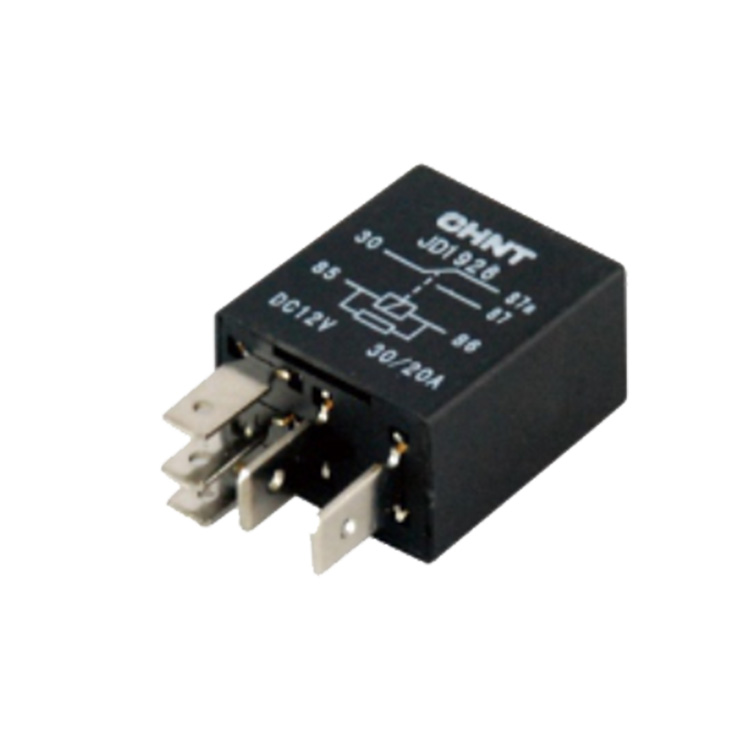Understanding Automotive Relays: Essential Components for Vehicle Electrical Systems
2025-04-11
In the world of modern automotive engineering, electrical systems have become more complex and integral to vehicle performance. From controlling lights and air conditioning to managing safety features and engine functions, electrical components are crucial for the smooth operation of a vehicle. One such essential component is the automotive relay. Despite their small size, relays play a critical role in ensuring the reliability and efficiency of a vehicle’s electrical system.
In this blog, we will dive into what automotive relays are, how they work, their types, and why they are so important for the modern vehicle.
What is an Automotive Relay?
An automotive relay is an electrically operated switch that allows a low current circuit to control a high current circuit. Relays are used in vehicles to control various electrical components such as headlights, fuel pumps, air conditioning systems, and more. The purpose of a relay is to provide a way for smaller electrical circuits to activate larger ones without the need for high-current wiring.
In simple terms, when a small current flows through the relay’s control circuit, it activates a magnetic field that triggers the relay to close or open its switch. This action allows the relay to control a larger current flowing through the connected load, such as a motor or light.
How Do Automotive Relays Work?
At the core of an automotive relay is an electromagnet. When a current flows through the relay’s coil, it generates a magnetic field that pulls a movable armature. This armature, in turn, closes or opens the switch contacts in the relay. There are typically two sets of contacts within a relay: a normally open (NO) and a normally closed (NC) set.
- Normally Open (NO) Contact: In its default state, the contacts are open, meaning the current does not flow through the connected circuit. When the relay is energized, the contacts close, completing the circuit and allowing current to flow.
- Normally Closed (NC) Contact: These contacts are closed by default, allowing current to flow in a circuit until the relay is energized, which opens the contacts and interrupts the current flow.
When the relay is activated, the electrical flow is directed to the component it is controlling, such as turning on the headlights or activating a motor. Once the relay is deactivated, the switch returns to its original state, stopping the current flow.
Types of Automotive Relays
Automotive relays come in various types, each suited for specific functions. The most common types include:
1. Electromagnetic Relays
These are the most common type of relay found in vehicles. They use an electromagnet to control the switch, as described earlier. Electromagnetic relays are typically used in low-to-moderate current applications, such as controlling lights, horns, and low-power motors.
2. Solid-State Relays
Unlike electromagnetic relays, solid-state relays do not have any moving parts. Instead, they use semiconductor materials to switch the current. Solid-state relays are more reliable and durable because they are less susceptible to wear and tear compared to their mechanical counterparts. These relays are often used in applications that require fast switching times or high-frequency control.
3. Time Delay Relays
Time delay relays are used when a component needs to be activated or deactivated after a certain period. These relays are typically used for controlling systems that require a delay, such as powering up air conditioning or activating safety systems in vehicles.
4. Miniature Relays
Miniature relays are smaller versions of the standard relays and are designed for use in compact spaces. These relays are often used in modern vehicles, where space is at a premium, and they control functions such as window motors, seat adjustments, or other small components.
Importance of Automotive Relays
Automotive relays serve several critical functions that are vital to a vehicle’s electrical system. Here’s why they are so important:
1. Protecting Electrical Components
By allowing low-power control circuits to activate high-power components, relays help prevent damage to sensitive parts like switches and wiring. This is especially important for preventing overloads or short circuits, which could lead to expensive repairs or even fires.
2. Ensuring Smooth Operation of Electrical Systems
In modern vehicles, many electrical systems work in tandem. Relays help manage the timing and sequencing of various components to ensure smooth and reliable operation. For example, when starting the engine, relays ensure that the fuel pump is powered at the right time, allowing the engine to start properly.
3. Improved Durability
Relays are designed to handle high-current loads, which allows them to take on tasks that would otherwise require thicker wires or heavier components. Their ability to withstand higher currents contributes to the durability of the overall vehicle electrical system.
4. Space and Energy Efficiency
Since relays allow for the control of high-power components with a small current, they help keep the vehicle’s electrical system efficient and compact. This space-saving feature is particularly important in modern vehicles, where space constraints are often a concern.
5. Increased Safety
Automotive relays also play a significant role in ensuring the safety of both the vehicle and its occupants. Many safety features in modern cars, such as airbags, anti-lock braking systems (ABS), and traction control systems, rely on relays to operate efficiently. These systems are critical for keeping drivers and passengers safe during everyday driving or in emergency situations.
Common Automotive Relay Applications
Automotive relays are used in a wide variety of applications across different vehicle systems. Some common uses include:
- Headlight and Taillight Control: Relays are often used to control the headlights, taillights, and turn signals, providing precise control over lighting functions.
- Fuel Pump Activation: Relays help control the fuel pump’s operation, ensuring that fuel is delivered to the engine at the right time.
- Air Conditioning Systems: Relays are used to control the activation of the air conditioning compressor and other components of the HVAC system.
- Horn Activation: The car horn is typically controlled by a relay, allowing the driver to sound the horn with minimal current draw.
- Power Windows and Seats: Relays are used to manage the operation of power windows and seats, providing smooth and reliable movement.
Conclusion
In conclusion, automotive relays are essential components of modern vehicle electrical systems. They serve the critical purpose of controlling high-power circuits with low-power signals, ensuring the safety, efficiency, and durability of various vehicle functions. From headlights to safety features, relays make it possible to operate complex systems in a vehicle while protecting sensitive components from damage.
Understanding how relays work and their role in a vehicle's electrical system highlights their importance. Whether you are an automotive professional or a car enthusiast, appreciating the functionality and versatility of automotive relays can give you a deeper insight into the intricate design of today’s vehicles.



